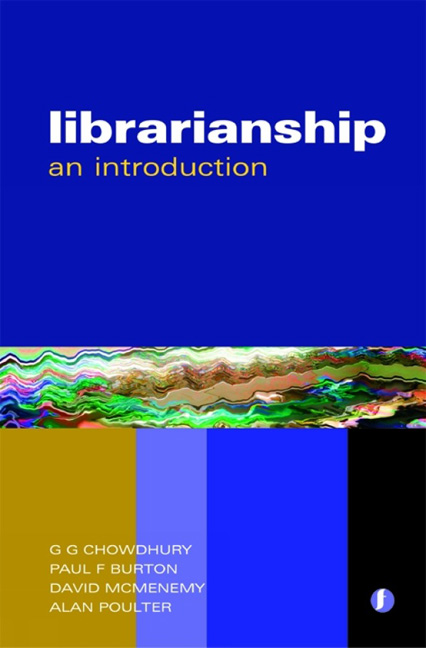Book contents
- Frontmatter
- Contents
- Preface
- Acknowledgements
- 1 Introduction
- Part 1 Libraries and information services: evolution or revolution?
- Part 2 Library and information resources and services
- Part 3 Information organization and access
- 10 Classification
- 11 Cataloguing, bibliographic formats and metadata
- 12 Subject indexing and vocabulary control
- 13 Information retrieval
- Part 4 Library and information users and society
- Part 5 Library technologies
- Part 6 Management and marketing in libraries
- Part 7 Education and research in librarianship
- Epilogue
- Glossary
- Resource list
- Index
11 - Cataloguing, bibliographic formats and metadata
from Part 3 - Information organization and access
Published online by Cambridge University Press: 08 June 2018
- Frontmatter
- Contents
- Preface
- Acknowledgements
- 1 Introduction
- Part 1 Libraries and information services: evolution or revolution?
- Part 2 Library and information resources and services
- Part 3 Information organization and access
- 10 Classification
- 11 Cataloguing, bibliographic formats and metadata
- 12 Subject indexing and vocabulary control
- 13 Information retrieval
- Part 4 Library and information users and society
- Part 5 Library technologies
- Part 6 Management and marketing in libraries
- Part 7 Education and research in librarianship
- Epilogue
- Glossary
- Resource list
- Index
Summary
Introduction
In the modern history of cataloguing several catalogue codes – tools used for preparing catalogues of bibliographic items – have emerged. The most prominent and widely used among them is the Anglo-American Cataloguing Rules, known under its second edition as AACR2. This is used as the de facto standard for cataloguing library resources all over the world, and the Online Computer Library Center (OCLC), the body responsible for the management of AACR2, has brought out guidelines for using AACR2 for cataloguing internet resources.
The main objective of this chapter is to provide an overview of the activities involved in cataloguing library resources, and the corresponding rules and standards/tools, and so on. The chapter also provides a brief introduction to AACR2, and some simple examples of catalogue records. After reading this chapter, readers should have an understanding of the basic concepts of cataloguing and catalogue records created according to AACR2.
History of library catalogues
Most of us are familiar with some form of catalogue, product catalogues (such as the Argos catalogue in the UK) being the most common, which simply speaking is a list of items, arranged in a specific order. A catalogue is formally defined as ‘a list of the contents of a particular collection of objects and is arranged in some definite order so as to facilitate the use of that collection, and a guide to its scope and content’ (Corbett, 1966, 297).
A library catalogue is defined as ‘an ordered compilation of item descriptions and sufficient information to afford access to entries’ (Clason, 1973). A library catalogue lets the user find out about a library's collection, i.e., it shows what the library has on a given subject, by a given author, and so on. A catalogue record aims to provide all the information of a given bibliographic item that is deemed necessary to get access to the item concerned.
Cataloguing is one of the oldest information organization activities and dates back over 2000 years. Evidence of some form of cataloguing activities has been noted as far back as 300 BC in the Library of Alexandria in ancient Egypt (Hanson and Daily, 1970).
- Type
- Chapter
- Information
- LibrarianshipAn introduction, pp. 103 - 114Publisher: FacetPrint publication year: 2007

